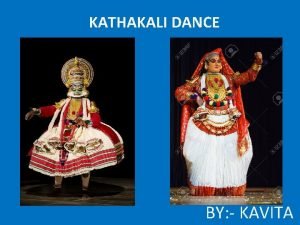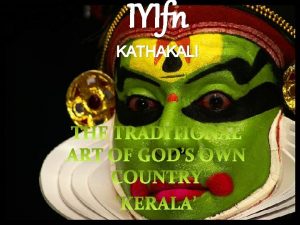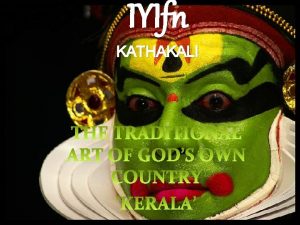Title Kathakali Dance The art of dance Unit3















- Slides: 15

Title : Kathakali Dance (The art of dance) (Unit-3) § By Shiuli Mahapatra

ØKATHAKALI , a form of ritual drama originated in Kerala. ØEvolving from earlier forms of dance drama such as KODIYATTAM, KRISHNATTAM, RAMANATTAM. ØIt was performed in palaces and temples and at religious festivals. ØKATHAKALI draws its subject matter from the Hindu epics chronicling the lives , loves and conflicts of the Gods and heroes of indian mythology like Ramayana , Mahabharata , Puran. .

ØThe Name “KATHAKALI” derives from Malayalam words “Katha” which means story and “Kali” which means play.

KATHAKALI is consideres to be a combination of five art forms like 1. Natyam (Acting) 2. Nritham(Dance) 3. Nrithyam (Enactment) 4. Sangeetham (Music) 5. Vadyam (Instrument accompaniment)

A traditional Kathakali performance is usually conducted at night and ends early in the morning. Kathakali is usually performed in front of a kalivilakku (“kali”= dance; “vilakku”= lamp), which provided light when the plays were performed inside temples, residences of nobles, and palaces. A Kathakali performance scheduled to begin at 10: 00 pm will be announced in a special manner by the loud playing of chenda, maddalam (percussion), elathalam and chengila (metal lic cymbals) during the evening, so that they can be heard even at a distance. This instrumental music, called kelikottu, is very familiar to lovers of Kathakali.

Ø A Kathakali actor needs immense powers of concentration, skill, and physical stamina, gained through training based on Kalaripayattu, the ancient martial art of Kerala. Training begins around the age of ten, and often lasts for eight to ten years. The training program is intensive; each day begins at 3: 30 am and ends at 8: 30 pm, with short breaks in between. During the monsoon and winter there are rigorous body massage sessions. Each student learns the complete language of Kathakali, memorizing the combinations of facial expressions (rasas), bodily movements and hand gestures (mudras). Dancers also undergo special practice sessions to learn control of their eye movements.

There are five main types of characters, usually identified by the predominant color of makeup applied to the face or its pattern: 1. pacha 2. kathi 3. thadi 4. kari 5. minukku

ØIn Kathakali, the pacha vesham with its predominant green colour is used to portray noble male characters like kings and divine beings. These characters have a mix of satvic (pious) and rajsik (kingly) nature. Characters like Lord Krishna and Lord Rama are examples of pacha vesham.

ØKathi charecters are proud , aggressive and unrighteous charecters such as demon king Ravana are though their make-up is basically green, denoting that they are high born, a red mark line on upturned moustache. They also have white knob on the tips of thin nose and on their foreheads.

ØThere are three varities of thadi. The most aggressive and demonic known as chuvanna thadi (red beard). Mythical and fabulous being like Bali (King of monkeys) are known as vella thadi (white beard), aboriginals, forest-men and cave dwellers are known as Karutha thadi (black beard).

The lowest and aggressive being are kari. It have small patterns of red , white and yellow on a completely black face.

It is used to represent women and sages. In Kathakali the female character are also performed by man. The vesham is used to represent gentleness and high spiritual standing and is charecterized with yellow facial paint. .

v. Head gear - Kirtam v. Ear rings – Tora v. Small ear rings – Chetipuru v. Red cloth are used below the head gear – Chuttitan v. False hair – Chamaram v. Wooden bangles – Tolput v. Necklace of beads – Kajuharam v. Ghaghra – uruteketta v. Ghungur of kathakali dance – Gochamoni v. Ladies scarf - Uruman

o Drama and art in education – Aniruddha Mukherjee o Kathakali – Wikipedia o www. newworldencyclopedia. org/entry/kathakali o http: //ccrtindia. gov. in/kathakali. php If you have any queries, please contact at – Phone number – 9732969846 Whattsapp no - 9800301705

THANK YOU
 Dance dance dance in the freedom we know
Dance dance dance in the freedom we know Kathakali music instruments
Kathakali music instruments Kathakali navarasam
Kathakali navarasam Let's dance unit3d
Let's dance unit3d Title fly and title page
Title fly and title page Title title
Title title It is a line dance that originated to a song in 2007
It is a line dance that originated to a song in 2007 Everybody dance and sing line dance
Everybody dance and sing line dance Geometry bell ringers
Geometry bell ringers The dance committee hired a dj for the fall dance
The dance committee hired a dj for the fall dance Just dance cultural appropriation
Just dance cultural appropriation Pop art title
Pop art title Hát kết hợp bộ gõ cơ thể
Hát kết hợp bộ gõ cơ thể Slidetodoc
Slidetodoc Bổ thể
Bổ thể Tỉ lệ cơ thể trẻ em
Tỉ lệ cơ thể trẻ em



























